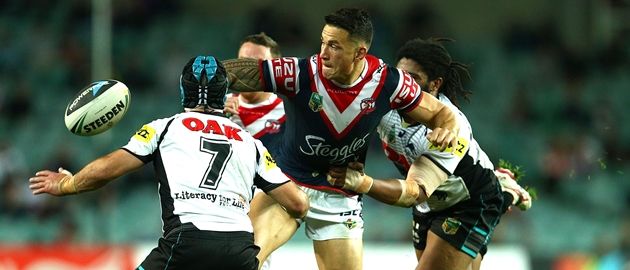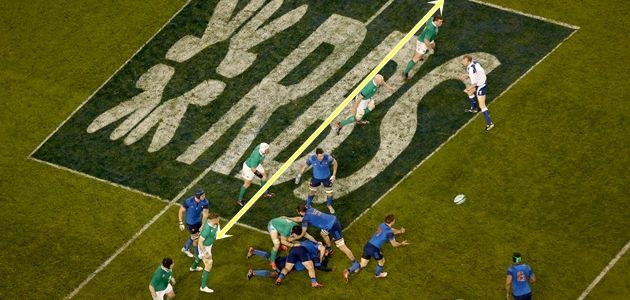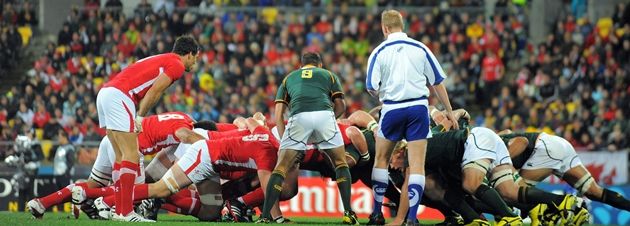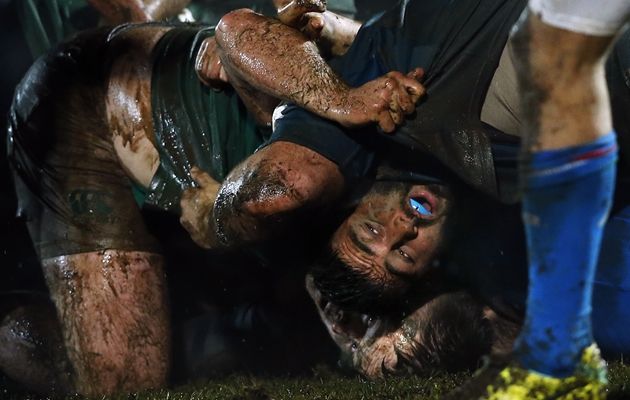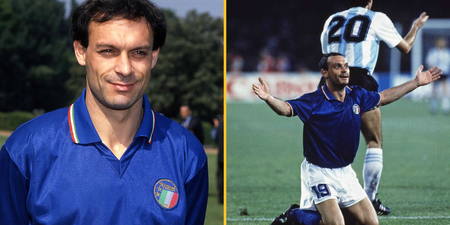Every year, the Six Nations begins with a bang and fizzles to a whimper before a tense finish settles on a winner.
The Southern Hemisphere superpowers keep a mocking eye on the rugby morasses as their own Super XV [or whatever Roman numeral it expands to] season nears.
The opening six matches in the Six Nations have produced one brutal classic [England v Wales], one toe-to-bigger-toe scoring extravaganza [England v Italy], and four middle of the road affairs. Ireland have been solid and unspectacular but, most importantly, triumphant.
Each Six Nations sparks debate on how to improve the game. To that end, here are some suggestions – some ours, some from other knowledgeable souls – that should improve the game. Or, at the very least, increase the entertainment levels.
1: Rugby League-style 13-a-side
PRO: The long-running rugby league debate. To move the game away from crash-ball, pick-and-stick merchants, take a player out of the pack and backline and free up the pitch for a attacking teams to explore.
CON: A drastic step. Tantamount to taking Gaelic footballers off the pitch to prevent blanket defending. Innovative coaches and players will figure their way around those who want to squeeze the life out of the game – South Africa vs. New Zealand 2013 [38-27 to the All Blacks] or 2014 [27-25 to the Springboks in 2014] are the perfect answers to does that believe 15 vs. 15 is too stuffy.
2: Bigger pitch
PRO: Similar to the 13-a-side notion but this would keep the traditionalists happy-er (sic). More space should leave to greater rewards to attacking teams.
CON: It could also bring us back to the days when teams flagged badly after 60 minutes and gaps opened up in defensive lines.
3: Weight limits per team
PRO: An interesting idea but one that might stall the creation of 15 vs. 15 hulking beasts. Each team is set a weight limit for their 15 players [or match-day squad]. This would allow for the odd, huge physical specimen but would mean stealthier, skillful players are not mashed out of the game completely.
CON: Could veer into the comedic. 12 big lads and three horse jockeys. Players going to saunas wrapped in black, plastic bags and weigh-ins with lads in boxers squaring off against each other. Sort out the rules and policing, not the size. Would be unfair on the preternaturally big in physique (ie: Pacific Islanders, South Africans).
4: Second referee to police offsides
PRO: There must be 350 offsides – of varying degrees and meterage – in each game and it often suffocates teams that want to play the running game and go wide. Very hard for one referee to police so why not bring in another referee or get the touch judges to follow the play – like football linesman – and keep and eye out for offsides and defensive lines pushing up before a ball is addressed or a pass considered [NZ Herald].
Actually, while he is at it, get the second ref to throw an eye over the other side of the scrum.
CON: When does adding another official ever speed up the process? Another soul to barrack and heckle.
5: Video official to deliver (close to) instant justice for dirty play
PRO: Flash a card (whatever colour you like) at the player suspected of foul play and let the game continue. If the video referee confirms a nefarious act, inform the referee through an earpiece and let him/her take swift action. Don’t wait to cite someone – like Pascal Papé – when the evidence is at your fingertips.
CON: The old ‘can of worms’ argument. If players and coaches know refs have the power to call for video reviews, they will be calling for them ad nauseum. A compromise could be the cricketing route – each team gets two challenges each.
6: More ex-players as referees
PRO: Not every referee has to have played at the top level to be decent but it would help the game no end if more former pros secured the necessary nominations.
CON: As former Leinster scrum-half Alain Rolland often found out, any decision that went Leinster’s way was pilloried and he was accused of favouritism
7: Free substitution for suspected concussions
PRO: To negate the temptation to rush a player back on, after a Head Injury Assessment, dispose of the 10-minute time window and let a team put a replacement on for as long as necessary. Better yet, if ANY PLAYER is suspected of a concussion, get them off and don’t let them back on. The 24th man [a choice of forward or back] could be the ‘concussion replacement’.
CON: How do you prove a player is concussed? Definitively, you cannot. Could lead to claims of foul play, exploitation and fakery.
8: Cut out rash kicks completely
PRO: Designate a ‘no boot’ area in and around rucks. We have seen far too many incidents of players getting kicks to the head and body by players recklessly hacking at balls and thinking about the collateral damage later.
CON: With no boots flying around, players might be more tempted to lie on the ball without fear of a shoeing.
9: NO MORE crooked scrum feeds
PRO: Very easy to police, very easy to see, but so often missed. Be harsh, cut it out, penalise the guilty parties and nip it in the bud. Once and for all.
CON: The argument is that without a slightly crooked feed, the hooker has to use one leg to hook the ball back and can’t engage properly, hence, leaving the attacking scrum at a disadvantage.
10: Make scrum penalties worth only two points
PROS: The contention is that some indiscretions are more serious than others. Of course, teams should still be rewarded for having a superior scrum but games should not be solely decided on something that is so often looked at subjectively and inconsistently by referees. Making scrum penalties worth only two points may see teams veer away from this scoring method and is espoused by former All Black Justin Marshall and SportsJOE rugby columnist David Wallace.
CON: Front five forwards, particularly the props, would be up in arms if their role was devalued in such a way. Having a strong, positive scrum, they may argue, must be worth its reward.
11: More benefit of the doubt TMO decisions
PRO: Defending players are now diving on top of, and beside, opponents in a deliberate effort to block TV cameras and make video replay decisions harder. How often have we seen what looks, for all the world, to be a try chalked off due to incomplete TV views. Give the benefit of the doubt more often and let us have more ‘Is the any reason why I cannot award the try?’ calls.
CON: As with offside calls in soccer, benefit of the doubt would lead to greater debate, focus on the decision-makers and take away from the players.
12: Stop scrum time-wasting
PRO: Teams are often more than happy to wind down the clock or influence the referee by time-wasting and getting scrums re-set. Give the attacking team one chance to get the ball in and out. If that fails, stop the clock until a penalty (either way) is awarded or the ball comes out cleanly. [Rugby World]
CON: None that we can see.
While we’re at it, get the ref to yell ‘Use it’ at scrum-time.
PRO: We hear this phrase at rucks and mauls but, in order to cut down on interminably long scrums, the referee shouts the words to signify no penalties will be given after this point as the attacking team have the ball available and are choosing not to use it.
CON: This would hinder pushovers. To remedy that, defer the ‘Use it’ call for an attacking scrum in the opposition 22. [Otago Times]
13: Get Nigel Owens to mentor more referees
PRO: The Welsh ref may not be every fans’ cup of officiating tea but we’ll say this for him, he likes a quick game. Games reffed by Owens are often more flowing, exciting affairs. He is the anti-Wayne Barnes [a whistle stickler] and rugby would be better off if there were more refs like him.
CON: Not everyone is a Nigel Owens fan. But, if he’s good enough for Doug Howlett, he’s good enough for us.
14: Discourage the choke tackle
PRO: Many former players [such as Will Greenwood] and pundits are not fans of the tactic – holding the ball-carrier up to win a turnover or scrum – and feel defending players should be made roll away quicker. Another option is to give the tackle-enveloped player more time to release the ball.
CON: Irish supporters won’t like this. This has been a favoured defensive method of ours since 2010 and, Les Kiss may protest, any changes would be unfair.
15: Power plays
There are two ways of applying this, slightly off-the-wall idea:
- A straight up call from each coach that sees points count as double for the attacking team and the defending team sacrifice a player for five minutes.
- Apply this ruling if a team receives a second yellow card in a game. It should free up space for the attackers, punish a cynical defending team and lead to a pulsating five minute window.
PRO: The sheer madness of it would lead to wild and woolly action.
CON: This ain’t cricket and Twenty-20. Don’t put lipstick on a pig.

